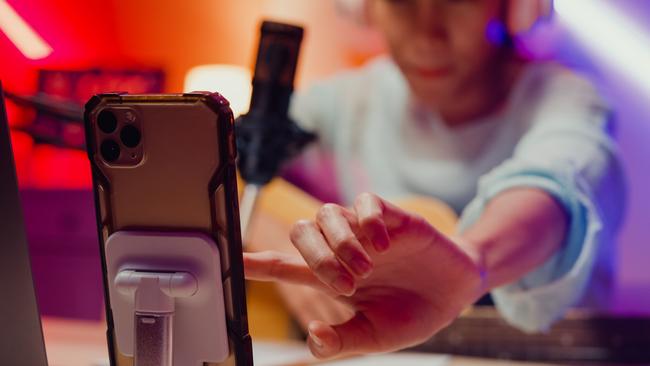Influencer is pre-teen dancer whose audience is 92pc men
After a mother started an Instagram account for her daughter, she grew to accept a grim reality: it meant building an audience including large numbers of men who take sexual interest in children.

The mum started the Instagram account three years ago as a pandemic-era diversion – a way for her and her daughter, a pre-teen dancer, to share photos with family, friends and other young dancers and mothers.
The two bonded, she said, as they posted photos of the girl dancing, modelling and living life in a small US Midwestern town.
The mother, a former marketing manager, oversaw the account and watched as the number of followers grew. Soon, photographers offered to take professional shots for the girl. Brands began sending free apparel for her to model.
“We didn’t even have the page for a month, and brands were like, ‘Can we send her dancewear?’” the mum said. “She became popular really fast.”
The mother also began to notice a disturbing trend in the data that showed up on the account dashboard: Most of the girl’s followers were adult men.
Men left public comments on photos of the daughter with fire and heart emojis, telling her how gorgeous she was. Those were the tamer ones. Some men sent direct messages proclaiming their obsessions with the girl. Others sent pictures of male genitalia and links to porn sites.
Sometimes the mum spent two to four hours a day blocking users or deleting inappropriate comments. At the same time, more sponsorships and deals were trickling in.
“It just kept growing, and then the brands weren’t just dance brands anymore,” the daughter, who’s now in high school, said. “It was actually really cool.”
The daughter loved coming up with creative posts. She told her mum she wanted to become an influencer, a “dream job” she could pursue after school and dance practice.
“It wasn’t like I was trying to push her to be a star, but part of me thought it was inevitable, that it could happen someday,” the mother said. “She just has that personality.”
The mother was torn. To reach the influencer stratosphere, the account would need a lot more followers – and she would have to be less discriminating about who they were.

Instagram promotes content based on engagement, and the male accounts she had been blocking tend to engage aggressively, lingering on photos and videos and boosting them with likes or comments. Running them off, or broadly disabling comments, would likely doom her daughter’s influencer aspirations.
That was a reason to say no. There were also reasons to say yes. The mum felt the account had brought her closer with her daughter, and even second- and third-tier influencers can make tens of thousands of dollars a year or more. The money could help pay for college, the mum thought.
The mother said yes. And with that, she grew to accept a grim reality: being a young influencer on Instagram means building an audience including large numbers of men who take sexual interest in children.
“It’s not that I liked it, ever. Ever. It just is what it is,” the mum said. At times, she’s questioned her decision to keep the account going. The account dashboard had recently put the number of male followers at 92 per cent.
At one point, she offered Instagram subscriptions to users willing to pay a monthly fee for extra photos and videos. Many of them were also men.
Thousands of other young female influencers, and their parents, have made similar calculations in using social media sites to promote posts and products. Parents have found that Instagram, owned by Meta Platforms, is a particular problem.
Instagram makes it easy for strangers to find photos of children, and its algorithm is built to identify users’ interests and push similar content.
Investigations by The Wall Street Journal and outside researchers have found that, upon recognising that an account might be sexually interested in children, Instagram’s algorithm recommends child accounts for the user to follow, as well as sexual content related to both children and adults.
That algorithm has become the engine powering the growth of an insidious world in which young girls’ online popularity is perversely predicated on gaining large numbers of male followers.
“If you want to be an influencer and work with brands and get paid, you have to work with the algorithm, and it all works with how many people like and engage with your post,” said the Midwestern mother. “You have to accept it.”

Meta has said that it has spent more than a decade working on keeping children safe online, and developed tools, features and resources to support teens and their parents.
In response to Journal articles over the past year showing how its algorithms connect paedophilic accounts and promote material that sexualises children, the company said it took a series of measures to remove violating accounts and enhance safety.
The company has been developing technology to identify accounts belonging to potentially suspicious adults. It said it has removed tens of thousands of such accounts in recent months.
Instagram photos of young girls become a dark currency, swapped and discussed obsessively among men on encrypted messaging apps such as Telegram.
The Journal reviewed dozens of conversations in which the men fetishised specific body parts and expressed pleasure in knowing that many parents of young influencers understand that hundreds, if not thousands, of pedophiles have found their children online.
One man, speaking about one of his favourite young influencers in a Telegram exchange captured by a child-safety activist, said that her mother knew “damn well” that many of her daughter’s followers were “pervy adult men”.
“We’re all model scouts, agents and brand owners,” another man replied in jest.
The Midwestern mum, in interviews by phone and at her home on a suburban cul-de-sac, said she tried to position herself as the barrier between her daughter and the paedophiles following along.
After she learned that her daughter’s photos were trading on Telegram, she sought brand partnerships offering school and leisure outfits instead of tight-fitting dancewear.

Meta looms over everything young influencers do on Instagram. It connects their accounts with strangers, and it can up-end their star turns when it chooses.
The company periodically shuts down accounts if it determines they have violated policies against child sexual exploitation or abuse. Some parents say their accounts have been shut down without such violations.
Over the course of reporting this story, during which time the Journal inquired about the account the mum managed for her daughter, Meta shut down the account twice. The mother said she believed she hadn’t violated Meta’s policies.
The Instagram posts started three years ago, the mother said. Her daughter, whom she describes as a “little ham” who loves the spotlight, had hundreds of photos from dance practice and competitions. She and her daughter enjoyed posting them and connecting with other young dancers online.
“It felt very safe,” her mother said. “Whether or not it was, it felt that way.”
Young influencers began following the account. But many followers lacked proper names and personal photos – signs of possible burner accounts for users with sexual interest in children to consume content anonymously. Some had crude or obscene usernames.
Meta’s guidance for content creators stresses the importance of engaging with followers to keep them and attract new ones. The hundreds of comments on any given post included some from other young fashion influencers, but also a large number of men leaving comments like “Gorgeous!” The mum generally liked or thanked them all, save for any that were expressly inappropriate.

Meta spokesman Andy Stone said the company enables parents who run accounts for their children to control who is able to message them on Instagram or comment on their accounts.
Meta’s guidance for creators also offers tips for building a safe online community, and the company has publicised a range of tools to help teens and parents achieve this.
The mum and daughter began putting in hours of work throughout the week to produce a steady stream of content. Some brands paid several hundred dollars for photos or Reels, with stipulations for how and when to post them.
Like many young girls, the daughter envied fashion influencers who made a living posting glamour content. When the mother agreed to help her daughter build her following and become an influencer, she set some rules.
Her daughter wouldn’t be allowed to access the account or interact with anyone who sent messages. And they couldn’t post anything indicating exactly where they live.
The mum stopped blocking so many users. Within a year of launching, the account had more than 100,000 followers. The daughter’s popularity earned her invitations to modelling events in big coastal cities where she met other young influencers.
Children, often with parental encouragement, have posed and performed for money for decades in beauty pageants, modelling gigs or acting spots. Predators have been there just as long, watching and participating.
Social-media platforms have helped level the playing field for parents seeking an audience for their children’s talents. Instagram, in particular, is visually driven and easily navigable, which also makes it appealing for child-focused brands.
But the platforms also have brought children and predators into closer contact. While Meta bans children under the age of 13 from independently opening social-media accounts, the company allows what it calls adult-run minor accounts, managed by parents.
Often those accounts are pursuing influencer status, part of a burgeoning global influencer industry expected to be worth $US480 billion ($727bn) by 2027, according to a recent Goldman Sachs report.
Young influencers, reachable through direct messages, routinely solicit their followers for patronage, posting links to payment accounts and Amazon gift registries in their bios.
The mum and daughter have been debating how to proceed. They offer some subscription content on another platform, but the majority of their followers were on Instagram.
The mother said she is now considering allowing her daughter to open a new Instagram account of her own – figuring Instagram would allow that – and leaving the girl to mostly manage it herself, with some oversight and limitations.
“She just wants to figure out how to keep working with her brands and do her job,” the mum said. “I would love to boycott Instagram altogether, but that’s really hard if you’re trying to work with brands.”
The Wall Street Journal







To join the conversation, please log in. Don't have an account? Register
Join the conversation, you are commenting as Logout